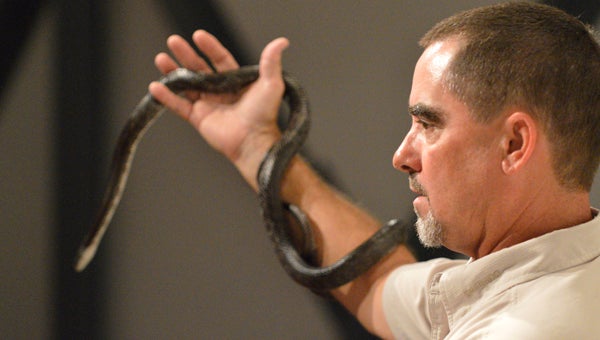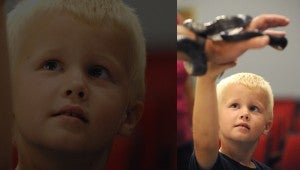Presentation sheds light on misunderstood creatures
Published 7:19 pm Tuesday, July 15, 2014

ASHLEY VANSANT | DAILY NEWS
SETTING THE RECORD STRAIGHT: Herpetologist Howard Vainwright showcases a Rat Snake to an audience at the NC Estuarium on Tuesday. The educational program, “Snakes of the East,” showed members of the audience that snakes are valuable and not bad as most people are taught.
Well-known Herpetologist Howard Vainwright presented “Snakes of the East” to an audience at the North Carolina Estuarium on Tuesday, providing information about one of nature’s misunderstood creatures.
Vainwright, who has worked with snakes for more than 30 years, gave an hour-long overview of North Carolina’s snake population. During the presentation, he highlighted some of the 37 species of snakes in the state, as well the differences between venomous and nonvenomous snakes. Thirty-one of the state’s snake species are nonvenomous and only four of the six venomous snakes in the state can be found in Beaufort County, according to Vainwright’s presentation.
“If you come across a snake, chances are it’s going to be nonvenomous,” Vainwright said.
Vainwright said the venomous snakes found in Beaufort County include the Copperhead, Pygmy Rattlesnake, Timber Rattlesnake and Cottonmouth, also referred to as a water moccasin. Vainwright had a display of each venomous snake to show the audience what each looked like as well as their average size.
Vainwright switched gears halfway through the presentation and brought out some of the region’s nonvenomous snakes, including a species of King Snake, a Corn Snake, an Eastern Hognose Snake and a Rat Snake, commonly referred to as a Chicken Snake. He provided specific information about each and allowed members of the audience to touch the snakes. This gave them a chance to interact with the snakes and change their attitudes about them, Vainwright said.

ASHLEY VANSANT | DAILY NEWS
INTERACTION: During Herpetologist Howard Vainwright’s presentation “Snakes of the East,” five-year-old Lexington resident Luke Smith, whose grandmother Diana Mathiesen is a Washington resident, got a chance to touch a Rat Snake.
People think snakes are out to get them and common practice is to kill them when they are seen, Vainwright said. However, according to his presentation, snakes are scared of humans and only bite in order to protect themselves.
“They are afraid of us — even the biggest snake in North Carolina,” Vainwright said. “If you’re standing beside him, he’s scared to death of you.”
Vainwright said peoples’ attitudes toward snakes are a primary reason he hosts educational presentations about them. He wants to give people important facts and an accurate portrayal of one of nature’s most feared and misunderstood creatures. In fact, one of the main reasons Vainwright was so intrigued by snakes and made it part of his life’s work is because people don’t like them, he said. Snakes are an important part of the food chain and keep rodents like mice and rats, as well as insects, small mammals, amphibians and other reptiles from overpopulating, Vainwright said.
“I’m trying to get people to understand that snakes are not what they think they are. My goal is to teach this younger generation that snakes are not bad. I really just want to get people to understand that snakes are valuable,” Vainwright said.
“Most of these adults are probably not going to change their attitudes a lot but these kids will. Most of the adults learn that in the Bible snakes are evil and they were taught to stay away from them and not to touch them because they are bad. These kids are learning they aren’t what they thought they were. If you can get these kids to learn early on that the snakes are good, they probably won’t have that fear of snakes as they get older.”





